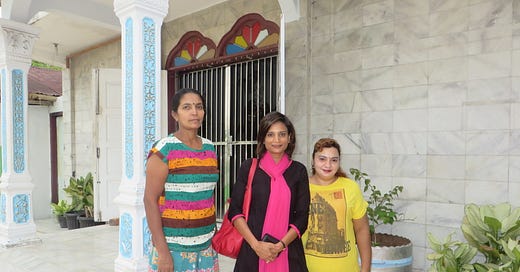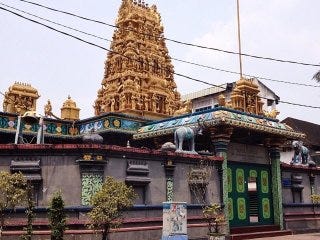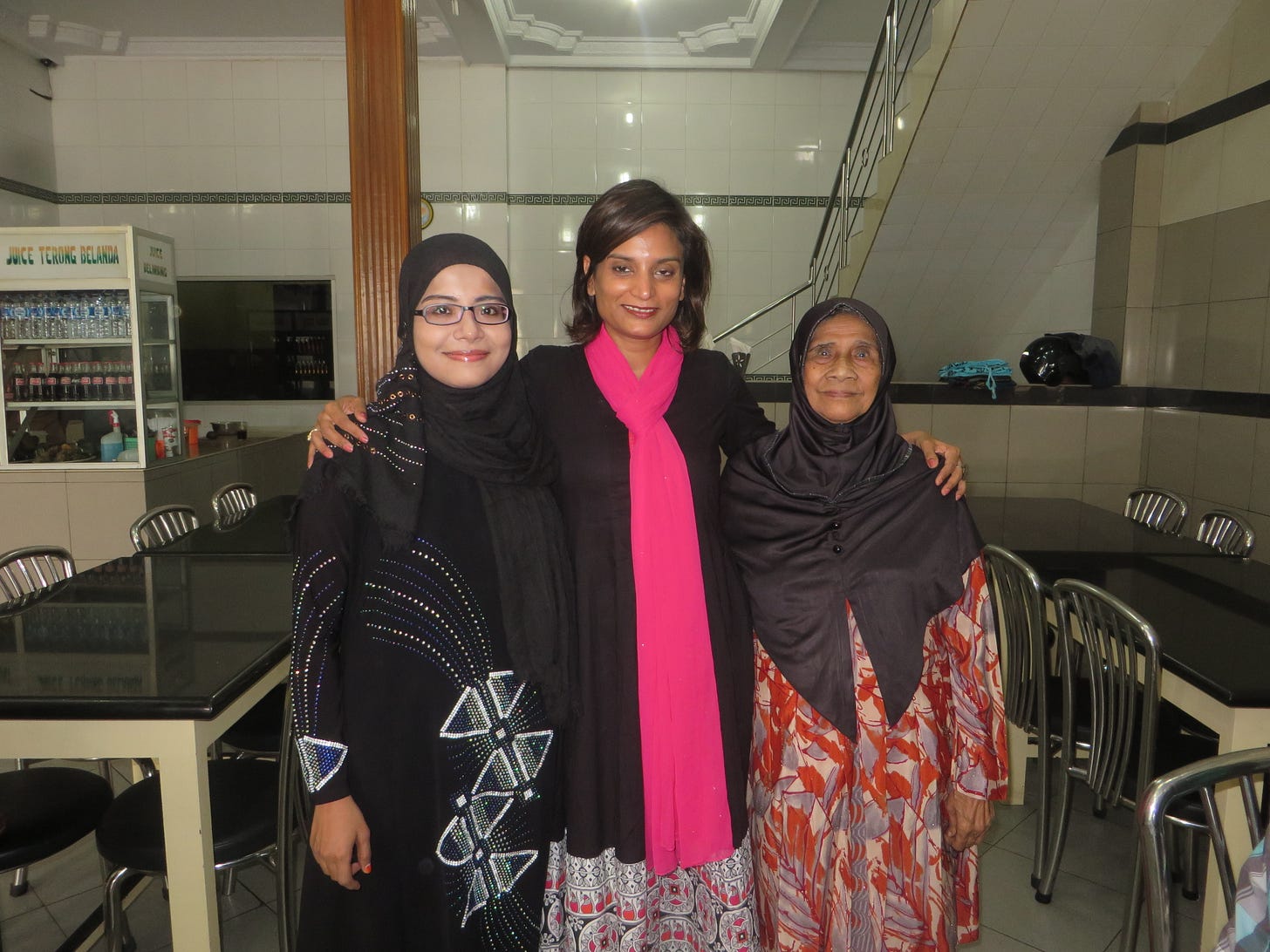Medan: A chequered history of Hinduism, Islam, colonialism and tobacco
The most Indian city in Indonesia, you've never heard of
Ni Hao GJ Folks,
Hope it’s been a good week for everyone. Today’s post is focused on a little-known Sumatran city, Medan, which has one of the world’s most diverse Indian diasporas. How the Indians ended up here is a fairly standard story of colonial-engendered migration, this one to do with the Dutch and tobacco and mediated by Malaysia.
Medan is a truly fascinating piece of the Global Jigsaw and I hope you enjoy this jaunt through the city’s past and present. If you do, please do switch to becoming a paid subscriber. This is a reader-supported newsletter, and is more in need of your support than ever :-) Thanks much.
****
Medan, a mid-sized city on the Indonesian island of Sumatra, is smoggy and crowded. The thrum of motorized rickshaws and the sizzle of street food carts dominates the auralscape. But what draws the eye is the wild pluralism of the religious architecture. The crush of retail shops and boxy apartment buildings is punctuated by the domes of mosques, steeples of churches and elaborate doorways of Hindu temples.
Many parts of Indonesia are resonant of its maritime neighbour, India. In Java’s great cities, ancient Hindu-Buddhist temples like Borobodur and Prambanan are testament to the civilizational links between the two countries. But there is a more contemporary Indian flavour to Medan than other Indonesian cities.
Medan’s busy central market is flecked with Indian restaurants and clothing stores. A gurudwara attached to a Khalsa school, is adjacent to a technicoloured goporum topped Mariamman temple. Masjid Taj Ul Madras, a mosque, is a short walk away. The entire neighbourhood is referred to as Kampung Madras, or “Madras town.”
Mariammen temple in Medan. Pic credit: Pallavi Aiyar
On the way to my hotel I passed a local high school where a banner with a large image of Ganesha wished students success in the upcoming examinations. The hotel bellhop, a young Muslim woman from a nearby town, told me she loves Indian music. I mentally prepared for her to sing one of Shah Rukh Khan Bollywood numbers, so beloved across Indonesia, but instead she launched into a word-perfect rendition of Mahatma Gandhi’s favourite devotional song, Raghu Pati Raghav Rajaram. It was fast evident that Medan had a special connection to India.
Even the name, Medan, is thought to derive from the Hindi word Maidan, meaning grounds.
North Sumatra, the tip of which is only 100 miles from India’s Andaman and Nicobar islands, was one of the first areas in the Indonesian archipelago to convert to Islam, as early as the 13th century. The influence of Indian Hinduism and Buddhism on Indonesia from the first century AD on, is well documented. But less know is the role of Gujarati Muslim traders in exporting Islam to the country that is today the world’s most populous Muslim nation.
For example, Nuruddin ibn Ali ar-Raniri, an Islamic mystic from Surat, lived for several years in the Sumatran court of the Sultan of Aceh. His work is considered amongst the oldest Islamic scholarship of Southeast Asia. Although few traces of Islam’s Indian connection to Indonesia remain today, in Padang, a city in western Sumatra, the tradition of Serak Gulo continues to highlight this historical association. This is a ritual where small sachets of sugar, packed in cotton bags are scattered from the rooftops of mosques every March, to celebrate the birth of Sahul Hamid, another Indian Islamic preacher credited with an influential role in introducing Islam to Sumatra.
But Medan-India ties date to the colonial era, when in the mid 19th century, Dutch companies began to import Indian labour, the majority from south Indian cities like Nagappattina, Madras, and Karrikal, to work in Sumatran tobacco and rubber plantations. These poor, illiterate, indentured labourers have largely been passed over by History, and there are few records that tell their story.
In a musty library set up by a former local royal, Tuanku Luckman Sinar, a pamphlet on “The Indians of North Sumatra” written by Sinar himself, is the only literature to be found on the community.
The Dutch contracted Indians, many of whom were already working in Malaysia, to construct roads, trenches and dykes, since local workers were thought to be lazy, “their whole nature to revolt against constant application to one particular routine” (Arnold Wright (ed) 20th Century Impressions of Netherlands India, 1909). The Indian diaspora in North Sumatra also included “free” Indians, mostly Chettiars and Chettis who worked as traders and moneylenders, as well as Sikhs who found jobs as security guards or dairy farmers.
The first Gurudwara in Medan was established in 1911 and the first Indian Catholic church in 1912. The Mariamman temple dates even further back to the 1880s. Today there are more than 15 Tamil Hindu temple organizations in North Sumatra alone.
One of the most intriguing characters I read about is a former Indian boxer called Young Sattar, who during the course of the Second World War helped organize a unit of the Indian National Army in Sumatra to fight against the Allied army.
Basir Ahmed, the Indian Counsel General in Medan at the time of my visit, did not have more information about Sattar, but he confirmed that there are around 60,000 people of Indian origin who live in Sumatra. Muslims from Bihar, Uttar Pradesh and Tamil Nadu have intermarried and integrated into local society, he said. The other groups have retained stronger ancestral identities.
I drove with an Indonesian employee of the Indian consulate to meet with “leaders” of the local Indian community, at a restaurant in Kampung Madras. We met Julius Raja, a Tamil who heads one of Medan’s Indian Associations, and Sukhdev Singh who represents the local Sikh community. Mr. Raja explained that he is a fourth generation Indonesia, his great grandfather having emigrated from Salem in Tamil Nadu. He works for the tax office and is unusual in having a government job. There are only around 20 Indians in Sumatra who work in government. Most remain poorly educated.
Mr. Singh described how his Kapurthala-born father came to Sumatra aboard a ship from Calcutta in 1942. (That north Indians usually traveled to Indonesia on ships from Bengal goes some way in explaining why all non-Tamils in Medan are referred to as Bengalis.) The father began trading in ghee before moving into cosmetics and textiles. Today, like most Sikh families in Medan, Mr. Singh owns a sporting goods store. He said there are around 850 Sikh families in the city, serviced by three Gurudwaras.
It was striking how stratified the Indians are, dispersed across autonomous Hindu, Christian, Sikh, Muslim and Buddhist organizations. The Buddhists are dalits (formerly known as untouchables) who converted after being denied entry to caste-Hindu temples. They now worship at Vihaaras that are funded, in part, by Chinese Buddhist associations. I met two women of Tamil origin at a Vihaara located off a barren piece of land on the outskirts of the city.
Meeting with two Buddhist women of Indian origin in Medan
They said that caste prejudice persists amongst the Indians of Medan and that the entry of dalits into Hindu temples remains barred, although it is illegal.
Rita Relia, an anthropologist at the University of Sumatera Utara who researches Medan’s Indian community, explained that unlike the Chinese, the Indians lack a single “community”, which goes some way in explaining why they remain economically backwards. But ironically, this poverty might have protected the Indians from the kind of racist attacks that Indonesia’s Chinese community (resented for its ostensible wealth) has often been at the receiving end of.
My last meeting was with a group of fifth generation Indian Muslims. Dressed in local-style clothes - the men in skullcaps, the women in hijabs -they told me that intermarriage with Sumatran Muslims is common. A toothless grandmother was found who could speak a few words of Tamil.
The rest had forgotten any Indian tongue. “We (Indian Muslims) have existed here (in Sumatra) for hundreds of years. We are part of here,” explained an elderly man called Abdul Muid.
Me with 5th generation Indian Muslims in Medan.
And yet they seemed attached to their Indian identity, despite not being able to name the towns of their ancestors in India. A young woman, the daughter of the restaurant owner were in, smiled shyly and began recounting the Indian words she knew. “Biryani, paratha, daal, chawal,” she giggled. “Do you know Shah Rukh Khan?” the girl’s husband, an ethnic Malay, asked hopefully.
******
That’s it for this week. Please share and leave a comment too. I love to hear your feedback, comments, and even your critiques :-)
Cheers,
Pallavi







Fascinating and truly insightful. Thankyou.
I wonder, what was the civilisation in North Sumatra before the Hindu colonisers arrived 2000 years ago?
Pallavi, thank you for digging Indian diaspora hiding in Medan and bringing them to the fore.